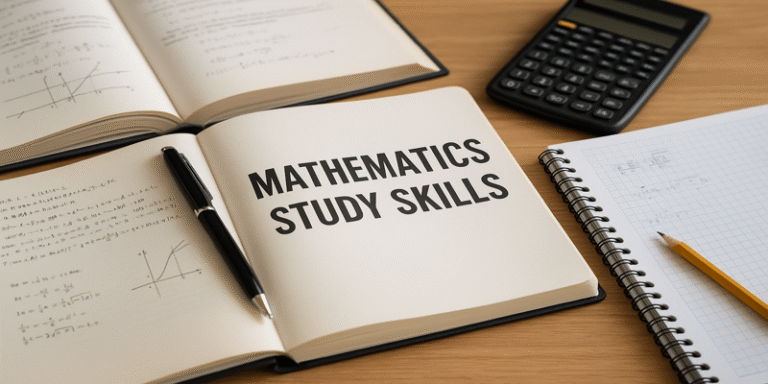Mathematics is more than numbers and formulas—it is a language of logic, structure, and patterns. Developing maths skills is essential not only for academic success but also for real-world applications in science, engineering, business, and social sciences. Four interrelated skills—reading mathematics, writing mathematics, solving problems, and mathematical modelling—form the foundation of effective mathematical learning and practice.
This article examines each skill in detail, illustrating their importance, challenges, and strategies for improvement. It also provides real-world examples and integrates insights from scholarly literature.
Reading Mathematics
Unlike narrative texts, mathematical reading requires interpreting dense symbolic language, definitions, theorems, and proofs. Reading in mathematics is active, demanding constant interaction with the text (Pimm, 1987).
Students often face difficulties because they attempt to read mathematics linearly, ignoring its hierarchical structure. For example, understanding a theorem requires familiarity with the definitions and lemmas that precede it (Weber, 2015). Effective strategies include:
- Previewing the structure of a chapter (definitions → theorems → proofs).
- Re-reading examples with worked solutions.
- Translating symbolic expressions into words and vice versa (Fadhilah & Purnamasari, 2025).
For instance, when reading about the Quadratic Formula, learners must connect symbolic notation (ax²+bx+c=0) with graphical representation (parabola) and real-world contexts (projectile motion).
Writing Mathematics
Mathematical writing is crucial for communicating ideas clearly and precisely. Unlike informal communication, it requires a balance between symbolic expressions and verbal explanation (Borwein & Devlin, 2001).
Good mathematical writing demonstrates:
- Clarity – using correct notation and avoiding ambiguity.
- Logical sequencing – presenting steps in the correct order.
- Justification – supporting each statement with reasoning or reference to prior results.
For example, writing a proof in geometry should include:
- Statement of assumptions.
- Step-by-step reasoning.
- A clear conclusion.
Errors in writing, such as misusing symbols or skipping steps, often hinder comprehension. Research by Sari & Sukoriyanto (2025) shows that many students’ errors in problem-solving stem from poor notation and model writing. Thus, teaching mathematical writing should be integrated into instruction, not treated as a secondary skill.
Solving Problems
Problem-solving lies at the heart of mathematics. According to Polya’s (1945) classic framework, effective problem-solving involves four steps: understanding the problem, devising a plan, carrying out the plan, and reflecting.
However, many students rush into calculations without fully understanding the problem statement. Nurazizah et al. (2025) emphasise that critical reading of word problems is essential before attempting a solution.
Strategies for effective problem-solving include:
- Breaking problems into smaller parts.
- Drawing diagrams or graphs.
- Checking results for reasonableness.
For example, in algebraic story problems, Saputra et al. (2025) identified common student errors at the reading and comprehension stage, leading to incorrect solutions. Teachers can mitigate this by training students to verbalise the problem in their own words before attempting calculations.
Mathematical Modelling
Mathematical modelling connects abstract mathematics with real-world contexts. It involves translating practical situations into mathematical form, solving them, and interpreting results (Blum & Leiß, 2007).
The process generally includes:
- Identifying the problem (e.g., predicting population growth).
- Formulating a model (e.g., exponential function).
- Solving the model (e.g., using logarithms to predict future values).
- Validating results against real data.
For example, in epidemiology, the SIR model is used to predict disease spread. Similarly, businesses use linear programming to optimise production schedules.
Recent studies highlight that students struggle with moving between real-world context and mathematical abstraction (Zula, Aryani & Riswari, 2025). Teachers must emphasise iterative modelling—refining assumptions when results do not match reality.
Integrating the Four Skills
While distinct, the four skills are interdependent:
- Reading mathematics aids comprehension of problems.
- Writing mathematics communicates reasoning in problem-solving.
- Problem-solving is the practical application of knowledge.
- Mathematical modelling demonstrates mathematics’ relevance to society.
Educators should design curricula that integrate these skills holistically. For example, project-based learning that requires students to read a problem context, model it mathematically, solve it, and present results in written form fosters mastery (Niileksela et al., 2025).
Challenges and Strategies
Several challenges affect students’ acquisition of these skills:
- Language barriers: Non-native English speakers struggle with technical mathematical vocabulary (Ishikawa, 2024).
- Cognitive overload: Students may focus on calculations while neglecting reasoning.
- Error patterns: Research using Newman’s error analysis shows frequent mistakes in reading and transforming problems (Lubis, Yuanita & Hutapea, 2025).
Strategies to address these include:
- Teaching mathematical literacy explicitly.
- Using cooperative learning models to encourage discussion (Tasir, 2024).
- Encouraging students to maintain math journals to practise both reading and writing.
Strong mathematical study skills are essential for success in both academic and professional contexts. Reading mathematics fosters comprehension, writing mathematics ensures clarity, problem-solving develops logical reasoning, and mathematical modelling demonstrates applicability to real-world issues.
Educators must support students in developing these interconnected skills through structured guidance, deliberate practice, and integration of authentic contexts. In an era of rapid technological and scientific advancement, mastering these skills ensures learners are equipped not only to succeed in mathematics but also to contribute meaningfully to society.
References
Blum, W. & Leiß, D. (2007) ‘How do students and teachers deal with modelling problems?’, Mathematics Education, 40(2), pp. 151–191.
Borwein, J. & Devlin, K. (2001) Mathematics: The New Golden Age. New York: Springer.
Fadhilah, L.N. & Purnamasari, V. (2025) ‘Exploration of the relationship between reading comprehension and solving mathematical word problems’, Innovative: Journal of Mathematics Education, 4(1), pp. 25–39.
Ishikawa, M. (2024) Influence of language used on the mathematization: Analysis based on cognitive linguistics. Tokyo: Researchmap.
Lubis, A., Yuanita, P. & Hutapea, N.M. (2025) ‘Error analysis in contextual problem solving’, Lattice: Journal of Mathematics Education, 7(2), pp. 55–70.
Niileksela, C.R., Hajovsky, D.B. & He, Z. (2025) ‘Cognitive-achievement relations with the Woodcock–Johnson V’, Journal of Psychoeducational Assessment, 43(1), pp. 88–103.
Nurazizah, S., Azira, M. & Rezky, M.Z. (2025) ‘Analysis of students’ errors in answering mathematical literacy questions’, Journal of Mathematics Education, 12(1), pp. 45–61.
Pimm, D. (1987) Speaking Mathematically. London: Routledge.
Polya, G. (1945) How to Solve It: A New Aspect of Mathematical Method. Princeton: Princeton University Press.
Saputra, S., Anggraini, A. & Sugita, G. (2025) ‘Analysis of errors in solving algebraic story problems’, Jurnal Pendidikan Matematika, 16(1), pp. 12–25.
Sari, N.P. & Sukoriyanto, S. (2025) ‘Students’ errors in solving set problems based on Newman’s procedure’, Desimal: Journal of Mathematics Education, 12(2), pp. 90–105.
Tasir, M.A. (2024) ‘The implementation of cooperative learning model type teams games tournament assisted by Schoology’, ICOESM Proceedings, pp. 231–240.
Weber, K. (2015) ‘The role of reading in learning mathematical proofs’, Educational Studies in Mathematics, 88(3), pp. 185–205.
Zula, Y.F., Aryani, D.S. & Riswari, L.A. (2025) ‘Difficulties in understanding mathematical story problems’, Algoritma: Jurnal Matematika dan Pendidikan Matematika, 7(1), pp. 77–92.









